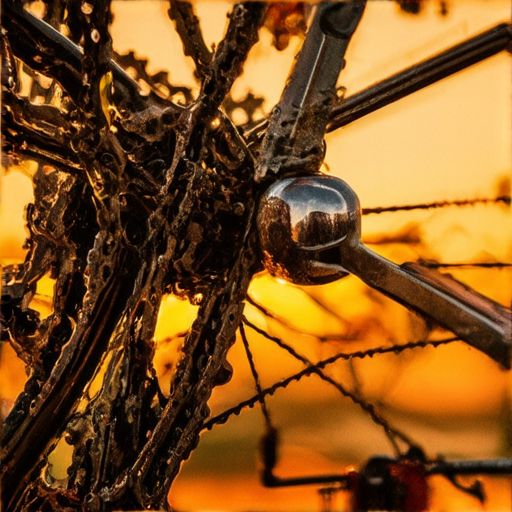Learning to repair a bike can seem daunting, especially for those who’ve never done it before, but it’s actually quite straightforward once you understand the basics. With a few simple tools and some basic knowledge, anyone can learn to fix their own bike, saving money and developing a deeper appreciation for the intricate mechanics that keep them rolling. Whether you’re looking to extend the life of your current bike or simply want to be self-sufficient when it comes to bike maintenance, knowing how to repair a bike is an essential skill that can benefit cyclists of all levels. So, let’s get started and explore the world of bike repair together, covering everything from the most common bike problems to more advanced techniques for keeping your ride running smoothly.
How to Repair a Bike Yourself
As a beginner, repairing a bike can seem intimidating, but with the right guidance, you can learn to fix common issues and keep your ride running smoothly.
In this guide, we’ll walk you through the process of repairing a bike, covering topics such as tire and wheel repairs, brake adjustments, and basic maintenance tasks.
According to Leeds Bicycle, a comprehensive resource for cycling enthusiasts, repairing a bike yourself can save you money and give you a sense of accomplishment.
Leeds Bicycle offers a wide range of bike repair guides, tutorials, and tips to help you get started.
For example, their bike repair list provides a detailed guide on how to perform common bike repairs, including tire and wheel repairs, brake adjustments, and basic maintenance tasks.
By following these steps and tips, you can learn to repair your bike yourself and enjoy the benefits of DIY bike repair.
Tire and Wheel Repairs
Removing the wheel and tire is the first step in most repairs.
Deflate the tire completely and remove the wheel using a wrench or socket.
If the tube needs replacement, follow these steps:
- Remove the entire wheel from the bike.
- Deflate the tire completely.
- Pull out the old tube, taking note of its orientation and placement.
- Inspect the rim for any sharp edges or debris.
- Install the new tube, making sure it’s properly seated and oriented.
- Reinstall the tire, ensuring it’s securely attached to the rim.
For more information on tire and wheel repairs, visit our bike repair list and follow the steps outlined in the guide.
You can also check out the tutorials and videos on Leeds Bicycle’s website for visual guidance on how to perform these repairs.
Check out our bike repair list for a comprehensive guide on how to perform common bike repairs.
Brake Adjustments
Adjusting brakes is crucial for safe riding.
Here’s how to do it:
Locate the brake caliper and adjust the pads according to the manufacturer’s instructions.
Check the brake cable tension and adjust as needed.
Test the brakes by applying gentle pressure to the levers.
For more information on brake adjustments, visit our bike repair list and follow the steps outlined in the guide.
You can also check out the tutorials and videos on Leeds Bicycle’s website for visual guidance on how to perform these repairs.
Check out our bike repair list for a comprehensive guide on how to perform common bike repairs.
Preparing for Bike Repair
Before starting any bike repair, it’s essential to prepare yourself with the right tools and knowledge.
What Tools Do I Need to Repair a Bike?
To begin with, you’ll need a basic toolkit that includes a pump, tire levers, Allen wrenches, and a screwdriver. For more complex repairs, you may need specialized tools like a bike stand or a wheel truing tool.
You can purchase these tools from online retailers like Leeds Bicycle or visit a local bike shop for assistance.
How to Choose the Right Bike Parts
Choosing the correct replacement parts can be overwhelming, especially for beginners. Research the specific part you need and consult with a professional if unsure.
A reputable online retailer like REI offers a wide selection of bike parts and accessories.
Understanding Bike Components and Terminology
Familiarize yourself with basic bike components like gears, brakes, and wheels. Understanding the terminology will help you navigate the repair process more efficiently.
The bike component guide on our website provides an excellent starting point for learning about bike components.
Essential Bike Maintenance Tasks
Regular maintenance is crucial to extending the lifespan of your bike. Set aside time each week to perform routine checks and adjustments.
Refer to our bike maintenance guide for a comprehensive overview of essential tasks.
Preparing for Bike Repair
Before starting any bike repair, it’s essential to prepare yourself and your bike for the process. At Leeds Bicycle, we recommend taking the following steps:
- Create a bike repair checklist to ensure you don’t miss any critical components.
- Understand your bike’s maintenance schedule to stay on top of regular checks and repairs.
- Learn about bike components and terminology to better understand the repair process.
- Perform essential bike maintenance tasks regularly to prevent major issues down the line.
- Inspect your bike before repairs to identify potential problems early on.
Common Bike Repairs
Bike repairs can range from simple adjustments to complex overhauls. At Leeds Bicycle, we offer expert guidance on common bike repairs, including:
- Fixing a flat tire
- Adjusting brake pads and cables
- Troubleshooting common bike issues
- Replacing a bike chain
- Repairing a bent frame
Safety Considerations
Bike repairs can be hazardous if not done properly. At Leeds Bicycle, we emphasize the importance of safety considerations, including:
- Safely disassembling a bike
- Working with sharp objects and tools
- Proper lifting techniques for heavy bikes
- Preventing injury during bike repairs
- Handling electrical components
Preparing for Bike Repair
Before starting any bike repair, it’s essential to prepare yourself with the right tools and knowledge.
What Tools Do I Need to Repair a Bike?
To begin with, you’ll need a set of basic tools, including a screwdriver, Allen wrenches, and a pump. For more complex repairs, you may require specialized tools like a chain breaker or a derailleur adjustment tool.
You can purchase these tools at a local bike shop or online retailers like Leeds Bicycle. It’s also recommended to familiarize yourself with the tools and their uses before attempting any repairs.
How to Choose the Right Bike Parts
Choosing the correct bike parts can be overwhelming, especially for beginners. To ensure compatibility, consult the manufacturer’s specifications or contact a local bike shop for guidance.
A reputable bike shop like Leeds Bicycle can provide expert advice on selecting the right parts for your bike.
Understanding Bike Components and Terminology
Bike components can seem intimidating, but understanding the basics can make a significant difference in your repair journey.
Start by learning the names and functions of common bike components, such as gears, brakes, and wheels. Websites like Leeds Bicycle offer detailed guides and tutorials to help you get started.
Essential Bike Maintenance Tasks
Regular maintenance is crucial to extending the lifespan of your bike. Some essential tasks include:
- Checking tire pressure and adjusting brakes regularly
- Cleaning the bike and applying lubricant to moving parts
- Inspecting the chain and adjusting tension
Refer to our bike maintenance guide for a comprehensive overview of essential tasks.
How to Inspect Your Bike Before Repairs
Before starting any repairs, take the time to inspect your bike thoroughly.
Check for signs of wear, damage, or corrosion, and make a note of any issues that need attention. A thorough inspection can help you identify potential problems before they become major issues.
Bike Repair Checklist and Schedule
Create a checklist of essential tasks to keep track of your bike’s maintenance schedule.
Set reminders for regular checks and repairs, and consider scheduling annual or bi-annual tune-ups with a professional mechanic.
Preparing for Bike Repair
Before embarking on a bike repair project, it’s essential to prepare yourself and your tools for success. At Leeds Bicycle, we recommend consulting online tutorials, repair manuals, or YouTube videos specific to your bike model to understand the necessary procedures.
What Tools Do I Need to Repair a Bike?
A well-stocked toolkit is crucial for any bike repair project. Some essential tools include a multi-tool, Allen wrenches, and a pump or CO2 cartridges for inflating tires. Visit our tools and accessories page to explore our range of bike repair tools.
How to Choose the Right Bike Parts
Choosing the correct bike parts can be overwhelming, especially for beginners. At Leeds Bicycle, we offer expert advice on selecting the right components for your bike. Our team can help you navigate the complexities of bike parts and ensure you get the best value for your money.
Understanding Bike Components and Terminology
Bike components and terminology can seem daunting, but understanding the basics is essential for any bike repair project. At Leeds Bicycle, we provide comprehensive guides and tutorials to help you learn the lingo and become a confident bike mechanic.
Essential Bike Maintenance Tasks
Regular bike maintenance is vital to extending the life of your bike and preventing costly repairs down the line. At Leeds Bicycle, we recommend scheduling regular checks and maintenance tasks, such as cleaning and lubricating bike parts, to keep your bike in top condition.
How to Inspect Your Bike Before Repairs
Inspecting your bike before repairs is crucial to identifying potential issues and avoiding costly mistakes. At Leeds Bicycle, we provide a step-by-step guide on how to inspect your bike and identify areas that need attention.
Bike Repair Checklist and Schedule
A bike repair checklist and schedule can help you stay organized and ensure you don’t miss any critical maintenance tasks. At Leeds Bicycle, we offer a comprehensive bike repair checklist and schedule to help you keep your bike in top condition.
How to Extend the Life of Your Bike
A well-maintained road bike can last anywhere from 10 to 15 years, depending on factors such as usage and component quality. However, high-performance cyclists may require more frequent replacements due to increased wear and tear.
Importance of Regular Maintenance
For optimal lifespan, regular maintenance is crucial, including:
- Cleaning and lubricating the chain every 100 miles.
- Rotating tires every 500 miles to ensure even tread wear.
- Adjusting brake pads annually to maintain optimal stopping power.
Studies have shown that well-cared-for bikes can exceed 20 years of service life when subjected to moderate use (Leeds Bicycle). In contrast, poorly maintained bikes may experience premature wear and failure within 5-7 years (Cycling Weekly).
Investing in High-Quality Components
To extend the lifespan of a bike, consider investing in high-quality components, such as:
- A reliable drivetrain system, featuring a Shimano Ultegra groupset or similar.
- High-strength wheels, constructed from lightweight materials like carbon fiber or titanium.
- Advanced braking systems, incorporating features like hydraulic disc brakes.
By prioritizing regular maintenance, upgrading components, and adopting best practices, cyclists can significantly increase their bike’s lifespan and enjoy years of trouble-free riding.
Preparing for Bike Repair
To begin with, it’s essential to understand that preparing for bike repair requires some planning and research.
What Tools Do I Need to Repair a Bike?
The type of tools needed may vary depending on the specific repair job, but a basic set of tools should include:
- A screwdriver set
- A wrench set
- A plier set
- A pump or CO2 cartridge for inflating tires
- A multi-tool or pocket knife
You can purchase these tools at a local bike shop or online retailer, such as Leeds Bicycle.
How to Choose the Right Bike Parts
Choosing the right bike parts can be overwhelming, especially for beginners.
When selecting new parts, consider factors such as compatibility, quality, and price.
You can consult with a professional mechanic or read reviews online to determine the best options for your bike.
For example, if you’re looking to replace your bike’s chain, consider purchasing a high-quality chain from a reputable manufacturer like Shimano.
Common Bike Repairs
Bike repairs can range from simple adjustments to complex overhauls.
Most Common Bike Problems and Solutions
Some of the most common bike problems include:
- Flat tires
- Brake pad wear
- Chain breakage
- Wheel trueness
These issues can usually be resolved with basic tools and knowledge, but it’s recommended to consult a professional mechanic if you’re unsure.
How to Fix a Flat Tire
Fixing a flat tire is a relatively simple process that can be completed with minimal tools.
First, locate the puncture and remove the wheel.
Next, inflate the tire with air or a CO2 cartridge, and then reattach the wheel.
Finally, tighten any loose bolts or nuts.
For more detailed instructions, visit our Fixing a Flat Tire Guide.
Safety Considerations
Bike repairs can pose risks if not done properly.
How to Safely Disassemble a Bike
Disassembling a bike requires caution and attention to detail.
Always refer to the owner’s manual or manufacturer’s instructions for specific guidance.
Additionally, consider wearing protective gear such as gloves and safety glasses.
For more information on bike safety, visit the Safety Tips Page on our website.
Advanced Bike Repairs
Some bike repairs require specialized skills and equipment.
How to Repair a Broken Gear System
Repairing a broken gear system can be challenging and requires expertise.
Consult a professional mechanic or seek guidance from a reputable source such as Cycling Weekly.
For more information on advanced bike repairs, visit our Advanced Repairs Page.

0 Comments